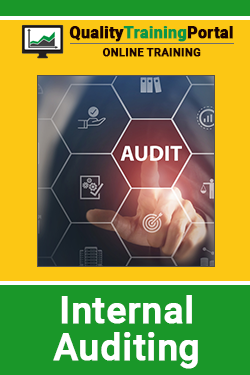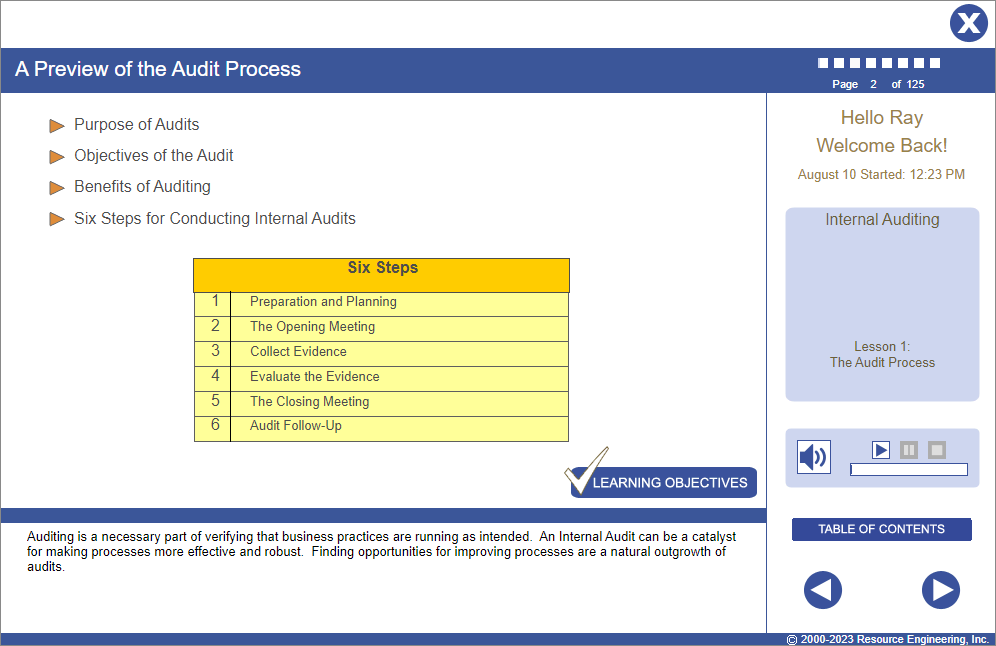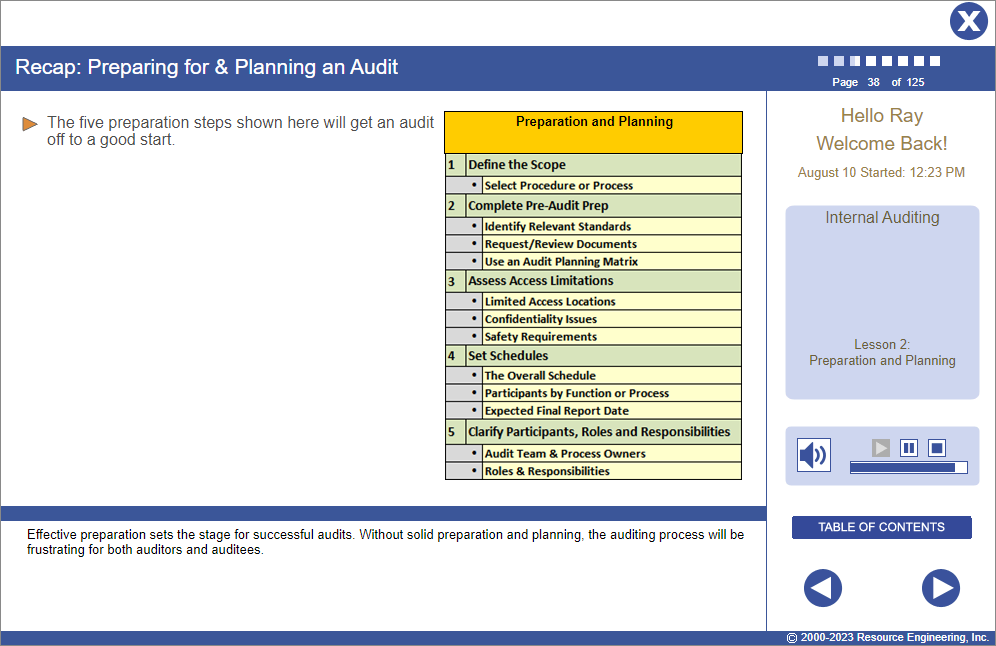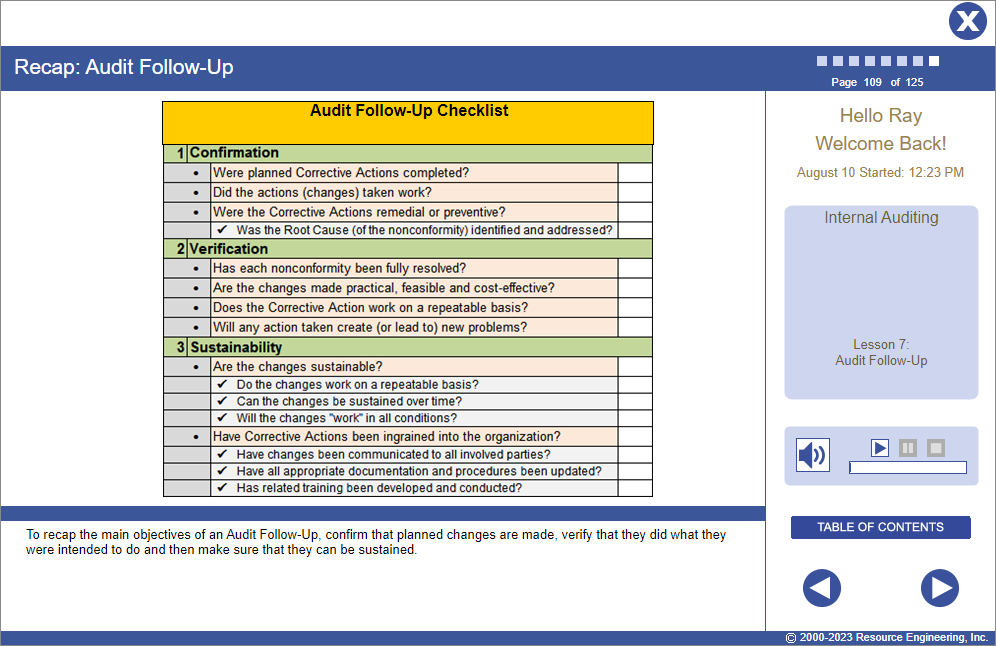Course Information
Internal Auditing Training
Learners will be able to:
- Describe the purpose, objectives, and benefits of Internal Audits.
- Use the six step internal audit process to conduct an Internal Audit.
- Make improvement recommendations using the audit results.

About This Course
Internal Audits are an effective, non-threatening way to confirm an organization does what it says it is doing in terms of documented procedures, work instructions and standard operating procedures as well as applicable industry standards and government regulations. As the term “audit” implies, a major task for the internal audit team is to look for non-conformities and then assure that Corrective Actions Plans are developed and implemented to return the related process to conformity. However, unlike audits done by third parties or others from outside of an organization, a unique feature of internal audits is that effective audit teams will also highlight “Opportunities for Improvement” that can proactively trigger process enhancements. Additionally, “Noteworthy Practices” that can be shared with other similar processes in the organization.
The most valuable internal audits are well-planned, highly coordinated events that minimize disruption to the operation. For this to happen, the members of the internal auditor team not only need to understand the basic audit process, but they need to know how to gather relevant information, to document what they see and hear and to dig deep in order to yield valuable insights.
Give your audit team the tools they need
This course, Internal Audit Training, prepares people to serve on internal auditor teams, but it is also valuable training for anyone involved in an internal audit either as an auditor or as someone who’s department or process is being audited. The course provides a foundation for conducting internal audits and will assure that all those involved in the audit (those doing the audit and those who’s processes are being audited) have a common understanding of the audit steps, general objectives and benefits of effective internal audits.
Upon successful completion of this training, participants will have a solid understanding of the purpose, objectives and benefits of Internal Audits. They will know the purpose and process for each of the six steps for conducting Internal Audits and will be able to plan and prepare for audits, participate in the audit itself collecting and evaluating evidence, write a final report and conduct a closing meeting.
- None
- English (EN-US)
- Chinese (simplified) (ZH)
- Czech (CS)
- French (FR)
- German (DE)
- Italian (IT)
- Japanese (no audio) (JA)
- Korean (no audio) (KO)
- Polish (PL)
- Portuguese (Brazilian) (PT-BR)
- Romanian RO)
- Russian (RU)
- Spanish (ES)
- Vietnamese (no audio) (VI)
Course Objectives
- Understand the purpose, objectives and benefits of Internal Audits.
- Describe in detail the six steps for conducting Internal Audits.
- Serve as a working member of an Internal Audit team.
- Describe how Internal Audits can be used to improve existing operations.
- Use the Ten Tips for more effective audits.
Course Outline
Lesson 1 – The Audit Process
- Understand the purpose, objectives and benefits of Internal Audits.
- Preview six steps for conducting Internal Audits.
Lesson 2 – Preparation and Planning
- Recognize that the bounds of the audit scope must be tightly defined and that staying within these bounds improves results.
- Understand how to prepare for an effective audit.
- Be aware of how important it is for all audit participants to remain objective.
Lesson 3 | The Opening Meeting
- Appreciate the importance of a comprehensive Opening Meeting.
- Know what agenda topics should be covered during the Opening Meeting.
Lesson 4 | Collect Evidence
- Recognize viable sources of evidence.
- Sort through the evidence to hone in on meaningful data that leads to valid conclusions.
- Realize when there is enough data gathered.
Lesson 5 | Evaluate the Evidence
- Consolidate evidence gathered.
- Generate a composite picture of how well the organization’s performance conforms to Standards and documented procedures.
- Separate and itemize nonconformities.
- Rate nonconformities against a simple, relative priority scale.
- Provide substantiated evidence of each nonconformity found.
Lesson 6 | The Closing Meeting
- Appreciate the purpose and importance of the Closing Meeting.
- Understand how to prepare the Audit Report.
- Know how to prepare for and lead the Closing Meeting.
Lesson 7 | Audit Follow-Up
- Recognize the need to confirm that changes made (at least for Critical and Major Nonconformities) have actually been made.
- Be aware of the need to verify that the changes made are the right changes.
- Know what to look for to ensure changes made are sustainable.
Lesson 8 | Auditing Tips
- Be aware of tips and techniques that can lead to more effective audits and efficient outcomes.
Challenge
- An assessment of the learner’s progress in this course.

4.6 out of 5 stars
Comments from Learners About This Course
- It is a comprehensive and easy-to-follow course. It also provides useful resources.
- This a great class for employees who are learning about Auditing.
- Good, happy with the course. Straightforward and to the point.
- Good content to introduce the auditing principles. I will use the plan for my future work at a supplier.
- A thorough and interesting overview of the auditing procedure which will be very valuable in the future.
- It was very helpful and informative. It was precise and concise, very user-friendly.
- Very straightforward. Easy to understand with multiple examples of all relevant instructional content. Thank you.
You may also be interested in…
- Internal Auditing for IATF 16949 – Training for Internal Auditors who work in organizations that comply with the IATF 16949 standard.
- 8D Problem-Solving – Step-by-step training in how to work on a problem-solving team follow the 8D methodology including tools and techniques that are used in each step.
- Root Cause Analysis with Corrective Action – Leads the learner through a four-step process to get to the root cause (source) of problems to eliminated problems for good.





